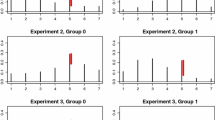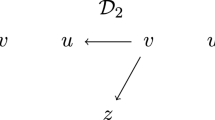Abstract
Graphical models have received an increasing amount of attention in network psychometrics as a promising probabilistic approach to study the conditional relations among variables using graph theory. Despite recent advances, existing methods on graphical models usually assume a homogeneous population and focus on binary or continuous variables. However, ordinal variables are very popular in many areas of psychological science, and the population often consists of several different groups based on the heterogeneity in ordinal data. Driven by these needs, we introduce the finite mixture of ordinal graphical models to effectively study the heterogeneous conditional dependence relationships of ordinal data. We develop a penalized likelihood approach for model estimation, and design a generalized expectation-maximization (EM) algorithm to solve the significant computational challenges. We examine the performance of the proposed method and algorithm in simulation studies. Moreover, we demonstrate the potential usefulness of the proposed method in psychological science through a real application concerning the interests and attitudes related to fan avidity for students in a large public university in the United States.






Similar content being viewed by others
References
Albert, J. H., & Chib, S. (1993). Bayesian analysis of binary and polychotomous response data. Journal of the American Statistical Association, 88(422), 669–679.
Allman, E. S., Matias, C., & Rhodes, J. A. (2009). Identifiability of parameters in latent structure models with many observed variables. The Annals of Statistics, 37(6A), 3099–3132.
Amemiya, T. (1974). Bivariate probit analysis: Minimum chi-square methods. Journal of the American Statistical Association, 69(348), 940–944.
Balakrishnan, S., Wainwright, M. J., & Yu, B. (2017). Statistical guarantees for the EM algorithm: From population to sample-based analysis. The Annals of Statistics, 45(1), 77–120.
Bock, R. D., & Gibbons, R. D. (1996). High-dimensional multivariate probit analysis. Biometrics, 52(4), 1183–1194.
Borsboom, D. (2008). Psychometric perspectives on diagnostic systems. Journal of Clinical Psychology, 64(9), 1089–1108.
Borsboom, D., & Cramer, A. O. (2013). Network analysis: An integrative approach to the structure of psychopathology. Annual Review of Clinical Psychology, 9, 91–121.
Borsboom, D., & Molenaar, D. (2015). Psychometrics. International Encyclopedia of the Social & Behavioral Sciences, 19(2), 418–422.
Breen, R., & Luijkx, R. (2010). Mixture models for ordinal data. Sociological Methods & Research, 39(1), 3–24.
Brusco, M. J., Steinley, D., Hoffman, M., Davis-Stober, C., & Wasserman, S. (2019). On Ising models and algorithms for the construction of symptom networks in psychopathological research. Psychological Methods, 24(6), 735–753.
Cai, T., Liu, W., & Luo, X. (2011). A constrained \(\ell _1\) minimization approach to sparse precision matrix estimation. Journal of the American Statistical Association, 106(494), 594–607.
Chen, S., Witten, D. M., & Shojaie, A. (2015). Selection and estimation for mixed graphical models. Biometrika, 102(1), 47–64.
Cheng, J., Li, T., Levina, E., & Zhu, J. (2017). High-dimensional mixed graphical models. Journal of Computational and Graphical Statistics, 26(2), 367–378.
Chib, S., & Greenberg, E. (1998). Analysis of multivariate probit models. Biometrika, 85(2), 347–361.
Cox, D. R., & Wermuth, N. (1994). A note on the quadratic exponential binary distribution. Biometrika, 81(2), 403–408.
Cramer, A. O., Waldorp, L. J., Van Der Maas, H. L., & Borsboom, D. (2010). Comorbidity: A network perspective. Behavioral and Brain Sciences, 33(2–3), 137–150.
Dalege, J., Borsboom, D., van Harreveld, F., van den Berg, H., Conner, M., & van der Maas, H. L. (2016). Toward a formalized account of attitudes: The causal attitude network (can) model. Psychological Review, 123(1), 2.
Danaher, P., Wang, P., & Witten, D. M. (2014). The joint graphical lasso for inverse covariance estimation across multiple classes. Journal of the Royal Statistical Society: Series B, 76(2), 373–397.
Dayton, C. M., & Macready, G. B. (1988). Concomitant-variable latent-class models. Journal of the American Statistical Association, 83(401), 173–178.
Dempster, A. P. (1972). Covariance selection. Biometrics, 28, 157–75.
Dempster, A. P., Laird, N. M., & Rubin, D. B. (1977). Maximum likelihood from incomplete data via the EM algorithm. Journal of the Royal Statistical Society: Series B, 39(1), 1–22.
DeSarbo, W. S. (2010). A spatial multidimensional unfolding choice model for examining the heterogeneous expressions of sports fan avidity. Journal of Quantitative Analysis in Sports, 6(2), 1–24.
DeSarbo, W. S., Chen, Q., & Blank, A. S. (2017). A parametric constrained segmentation methodology for application in sport marketing. Customer Needs and Solutions, 4(4), 37–55.
Dwivedi, R., Ho, N., Khamaru, K., Wainwright, M. J. & Jordan, M. I. (2018), Theoretical guarantees for the EM algorithm when applied to mis-specified gaussian mixture models. In Proceedings of the 32nd international conference on neural information processing systems (pp. 9704–9712).
Epskamp, S., Maris, G., Waldorp, L. J. & Borsboom, D. (2018). Network psychometrics. The Wiley handbook of psychometric testing: A multi-disciplinary reference on survey, scale and test development (pp. 953–986).
Epskamp, S., Rhemtulla, M., & Borsboom, D. (2017). Generalized network psychometrics: Combining network and latent variable models. Psychometrika, 82(4), 904–927.
Fan, J., & Li, R. (2001). Variable selection via nonconcave penalized likelihood and its oracle properties. Journal of the American statistical Association, 96(456), 1348–1360.
Fan, J., Liu, H., Ning, Y., & Zou, H. (2017). High dimensional semiparametric latent graphical model for mixed data. Journal of the Royal Statistical Society: Series B, 79(2), 405–421.
Fan, J., Xue, L., & Zou, H. (2014). Strong oracle optimality of folded concave penalized estimation. The Annals of Statistics, 42(3), 819.
Feng, H., & Ning, Y. (2019). High-dimensional mixed graphical model with ordinal data: Parameter estimation and statistical inference. In The 22nd international conference on artificial intelligence and statistics (pp. 654–663).
Fried, E. I., Bockting, C., Arjadi, R., Borsboom, D., Amshoff, M., Cramer, A. O., et al. (2015). From loss to loneliness: The relationship between bereavement and depressive symptoms. Journal of Abnormal Psychology, 124(2), 256.
Friedman, J., Hastie, T., & Tibshirani, R. (2008). Sparse inverse covariance estimation with the graphical lasso. Biostatistics, 9(3), 432–441.
Greene, W. H., & Hensher, D. A. (2003). A latent class model for discrete choice analysis: Contrasts with mixed logit. Transportation Research Part B: Statistical Methodology, 37(8), 681–698.
Grün, B., & Leisch, F. (2008). Finite mixtures of generalized linear regression models. In Recent advances in linear models and related areas (pp. 205–230). Springer.
Guo, J., Levina, E., Michailidis, G., & Zhu, J. (2011). Joint estimation of multiple graphical models. Biometrika, 98(1), 1–15.
Guo, J., Levina, E., Michailidis, G., & Zhu, J. (2015). Graphical models for ordinal data. Journal of Computational and Graphical Statistics, 24(1), 183–204.
Haslbeck, J. M., & Waldorp, L. J. (2016). mgm: Structure estimation for time-varying mixed graphical models in high-dimensional data 30, 39–81. arXiv:1510.06871
Höfling, H., & Tibshirani, R. (2009). Estimation of sparse binary pairwise Markov networks using pseudo-likelihoods. Journal of Machine Learning Research, 10, 883–906.
Huang, T., Peng, H., & Kun, Z. (2017). Model selection for Gaussian mixture models. Statistica Sinica, 27(1), 147–169.
Ising, E. (1925). Beitrag zur theorie des ferromagnetismus. Zeitschrift für Physik, 31(1), 253–258.
Isvoranu, A.-M., van Borkulo, C. D., Boyette, L.-L., Wigman, J. T., Vinkers, C. H., Borsboom, D., et al. (2016). A network approach to psychosis: Pathways between childhood trauma and psychotic symptoms. Schizophrenia Bulletin, 43(1), 187–196.
Lafit, G., Tuerlinckx, F., Myin-Germeys, I., & Ceulemans, E. (2019). A partial correlation screening approach for controlling the false positive rate in sparse Gaussian graphical models. Scientific Reports, 9(1), 1–24.
Lauritzen, S. L. (1996). Graphical models. Oxford: Clarendon Press.
Lee, J. D., & Hastie, T. J. (2015). Learning the structure of mixed graphical models. Journal of Computational and Graphical Statistics, 24(1), 230–253.
Lee, K. H., & Xue, L. (2018). Nonparametric finite mixture of Gaussian graphical models. Technometrics, 60(4), 511–521.
Liu, H., Lafferty, J., & Wasserman, L. (2009). The nonparanormal: Semiparametric estimation of high dimensional undirected graphs. Journal of Machine Learning Research, 10, 2295–2328.
Lwin, T., & Martin, P. (1989). Probits of mixtures. Biometrics, 45(3), 721–732.
Ma, S., Xue, L., & Zou, H. (2021). Alternating direction methods for latent variable Gaussian graphical model selection. Neural Computation, 25(8), 2172–2198.
Marsman, M. (2019). The idiographic ising model. PsyArXiv Preprints https://psyarxiv.com/h3ka5.
Marsman, M., Borsboom, D., Kruis, J., Epskamp, S., van Bork, R., Waldorp, L., et al. (2018). An introduction to network psychometrics: Relating Ising network models to item response theory models. Multivariate Behavioral Research, 53(1), 15–35.
Marsman, M., Waldorp, L., & Borsboom, D. (2019). Towards an encompassing theory of network models. PsyArXiv Preprints https://psyarxiv.com/n98qt.
Meinshausen, N., & Bühlmann, P. (2006). High-dimensional graphs and variable selection with the lasso. The Annals of Statistics, 34(3), 1436–1462.
Meinshausen, N., & Bühlmann, P. (2010). Stability selection. Journal of the Royal Statistical Society: Series B, 72(4), 417–473.
Rand, W. M. (1971). Objective criteria for the evaluation of clustering methods. Journal of the American Statistical Association, 66(336), 846–850.
Ravikumar, P., Wainwright, M. J., & Lafferty, J. D. (2010). High-dimensional Ising model selection using \(\ell _1\)-regularized logistic regression. The Annals of Statistics, 38(3), 1287–1319.
Ruan, L., Yuan, M., & Zou, H. (2011). Regularized parameter estimation in high-dimensional Gaussian mixture models. Neural Computation, 23(6), 1605–1622.
Schmittmann, V. D., Cramer, A. O., Waldorp, L. J., Epskamp, S., Kievit, R. A., & Borsboom, D. (2013). Deconstructing the construct: A network perspective on psychological phenomena. New Ideas in Psychology, 31(1), 43–53.
Städler, N., Bühlmann, P., & Van De Geer, S. (2010). \(\ell _1\)-penalization for mixture regression models. Test, 19(2), 209–256.
Suggala, A. S., Yang, E., & Ravikumar, P. (2017). Ordinal graphical models: A tale of two approaches. In International conference on machine learning (pp. 3260–3269).
Tibshirani, R. (1996). Regression shrinkage and selection via the lasso. Journal of the Royal Statistical Society: Series B, 58(1), 267–288.
von Davier, M., & Carstensen, C. H. (2007). Multivariate and mixture distribution Rasch models: Extensions and applications. Berlin: Springer.
Wedel, M. (2002). Concomitant variables in finite mixture models. Statistica Neerlandica, 56(3), 362–375.
Wedel, M., & DeSarbo, W. S. (1995). A mixture likelihood approach for generalized linear models. Journal of Classification, 12(1), 21–55.
Xue, L., & Zou, H. (2012). Regularized rank-based estimation of high-dimensional nonparanormal graphical models. The Annals of Statistics, 40(5), 2541–2571.
Xue, L., Zou, H., & Cai, T. (2012). Nonconcave penalized composite conditional likelihood estimation of sparse Ising models. The Annals of Statistics, 40(3), 1403–1429.
Yao, W. (2015). Label switching and its solutions for frequentist mixture models. Journal of Statistical Computation and Simulation, 85(5), 1000–1012.
Yuan, M., & Lin, Y. (2007). Model selection and estimation in the Gaussian graphical model. Biometrika, 94(1), 19–35.
Author information
Authors and Affiliations
Corresponding author
Additional information
Publisher's Note
Springer Nature remains neutral with regard to jurisdictional claims in published maps and institutional affiliations.
The authors wish to recognize and thank the Co-Editors, the Associate Editor, and three anonymous referees for their insightful and constructive comments.
The work of Lingzhou Xue was supported in part by the National Science Foundation (NSF) Grants DMS-1811552, DMS-1953189, and CCF-2007823.
Supplementary Information
Below is the link to the electronic supplementary material.
Rights and permissions
About this article
Cite this article
Lee, K.H., Chen, Q., DeSarbo, W.S. et al. Estimating Finite Mixtures of Ordinal Graphical Models. Psychometrika 87, 83–106 (2022). https://doi.org/10.1007/s11336-021-09781-2
Received:
Revised:
Accepted:
Published:
Issue Date:
DOI: https://doi.org/10.1007/s11336-021-09781-2




